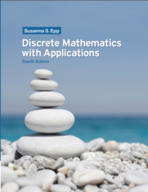Explain how each statement in 51 and 52 follows from
Chapter 11, Problem 52E(choose chapter or problem)
Problem 52E
Explain how each statement in 51 and 52 follows from exercise 50, exercise 13, and parts (a) and (c) of exercise 49.
Reference 1:
a. Let x be any positive real number. Use mathematical induction to prove that for all integers n ≥ 1, if x ≤ 1 then xn ≤ 1.
b. Explain how it follows from part (a) that if x is any positive real number, then for all integers n ≥ 1, if xn > 1 then x > 1.
c. Explain how it follows from part (b) that if x is any positive real number, then for all integers n ≥ 1, if x > 1 then x1/n > 1.
d. Let p, q, and s be positive integers, let r be a nonnegative integer, and suppose p/q > r/s. Use part (c) and the result of exercise 15 to prove property (11.2.1). In other words show that for any real number x, if x > 1 then x p/q > xr/s .
Reference 2:
Reference 3:
Another approach to proving part of the theorem on polynomial orders uses properties of O-notation.
a. Show that if f, g, and h are functions from R to R and f (x) is O(h(x)) and g(x) is O(h(x)), then f (x) + g(x) is O(h(x)).
b. How does it follow from part (a) and Theorem 11.2.1(3) that
c. The result of exercise 11 states that if f is a function from R to R, f (x) is O(g(x)), and c is any nonzero real number, then cf (x) is O(g(x)). How does it follow from this result and part (a) that
d. Use the results of part (a) and exercise 11 to show that if n is any positive integer and
Unfortunately, we don't have that question answered yet. But you can get it answered in just 5 hours by Logging in or Becoming a subscriber.
Becoming a subscriber
Or look for another answer
